| History of Colton, CA
1775 - THE PIONEERS OF COLTON
The City of Colton was formally founded in 1875 and incorporated
in 1887 but its history goes back to the 1770's when several explorers
from Mexico searched routes from Sonora, Mexico to Monterey, bringing the
first Europeans to the Colton area. Prior to this time, the area was inhabited
by the Gua-chama, Seranno and San Gorgonio Indians.
By 1840 Colton was part of two large privately owned ranchos,
the Jurupa and the San Bernardino Ranchos. The southwest section of Colton
is referred to as Agua Mansa (“Gentle Waters”); the area settled by New
Mexico Pioneers in 1842.
The town of Colton was laid out when the Southern Pacific
Railway was constructed through the valley on its way eastward from Los
Angeles in 1875. Colton was named for Civil War General David Colton who
was also Vice President of the Southern Pacific Railroad Company.
| 1876 - RESIDENTS
From a photograph taken in 1876, the entire population
of the then new town, except for Mr. and Mrs. Noel Davenport who were away
from home at the time. |
..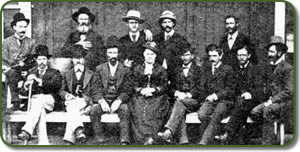 |
| 1885 - Cooley Ranch Approximately
For nearly 100 years, Cooley Ranch was also known as Indian
Knolls. The name derived when the Indians in the San Bernardino Valley
found refuge on the knolls of the property during the flood of 1862. Original
owner of the property was George Cooley, born in Kent, England. He came
to the area in 1853 and in 1854 purchased 200 acres at $3.50 per acre along
the Santa Ana River. Mr. Cooley was Chairman of the Board of Supervisors
of San Bernardino County. By 1873, the ranch was 19 years old with 400
acres, all in Colton. Because of high taxes, the ranch was sold to Villelli
Enterprises of La Habra. It is now the Cooley Ranch and construction began
in 1975. |
..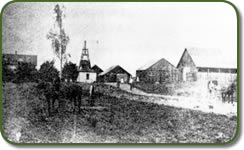 |
|
| 1887 - Virgil Earp, 1887, first Marshall of Colton
Colton was incorporated July 11, 1887 when 119 of 176
citizens voted in favor of incorporation. Nicholas P. Earp, father of the
“Earp Brothers”owned the Gem, a saloon, while he was the City Clerk for
Colton. Wyatt Earp applied to City Hall to operate a gambling hall in Colton,
but was turned down. The Nicholas Porter Earp family settled in Colton
in 1877; Nicholas was elected to the position of Recorder in 1887. The
same year, Virgil Earp was elected Colton's first Marshal and lived with
his wife Allie in a house at 528 W. H. Street which still stands today. |
..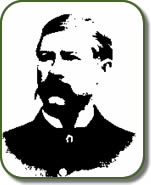 |
| 1887 - Morgan Earp Grave - Hermosa Cemetery in
Colton. |
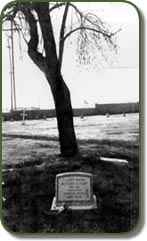 |
| 1889 - First City Hall
On October 16, 1889, Colton voted $12,000 in bonds for
the erection of a City Hall completed in 1890. The first meeting in City
Hall was convened September 1, 1890.
Through the next century, citrus groves were bought and
sold, the railroads and road systems grew to accommodate the growth, business
grew and so did the city. |
..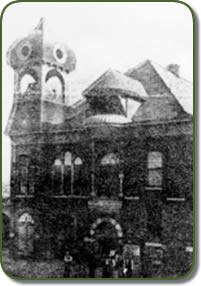 |
| 1891 - Colton Library - Built as the Carnegie Library
The building now housing the Colton Museum on La Cadena
Drive was originally a Carnegie Public Library. Andrew Carnegie, founder
of Carnegie Steele Co., initiated a project in 1891 to donate money to
towns and cities across the country for the building of public Libraries.
Carnegie distributed $68,333,973 to build 1,689 public libraries in the
united States and 830 in other countries. The Colton Woman's Club initiated
the campaign and Cramer B. Morris, City Attorney, negotiated the $10,000
donation from the Carnegie foundation to build a library here.
The City Council agreed to set aside $1,000 annually for
the building's maintenance and residents of Colton contributed $4,000 for
purchase of the site. The first 1,100 books were donated by the Woman's
Club who held “Book Showers” to raise money to purchase books. The building
was completed in 1908. Three other Carnegie libraries built in San Bernardino
County were in San Bernardino, Ontario, Upland. Only the buildings in Colton
and Upland are still standing. In addition to housing the library, Club
Rooms in the building's basement were utilized by groups such as the Boy
Scouts and Kiwanis club, chapels for Methodist and Presbyterian religious
and marriage services. During World War II, Red Cross volunteers met there
to prepare bandages for wounded service personnel.
Now the site of Colton Museum, once the Colton City Library,
located
on La Cadena Drive, south of City HallCarnegie Library. |
..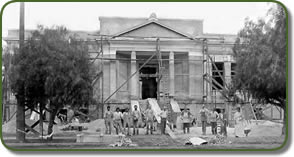
.
.
.
.
.
..
.
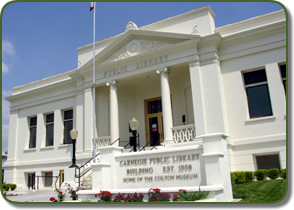 |
1896 - Colton Electric Utility
Colton Electric Utility is the second oldest municipal
electric utility in the State of California. Formally established in 1896
by passage of an ordinance to provide for “intention to acquire, construct,
own, operate and maintain a public electric light system for supplying
lights, power to the city residents”. The issue was passed 114 to12 by
a vote of the citizens and the plant, costing $6,000 was built. Additional
services and expansion has occurred over the next 100+ years and In 2003
the Agua Mansa Power Plant was built and dedicated. It is a GE LM 6000,
50 Mega Watt gas fired turbine generator; it generates 43 mega watts for
the city on average.
| 1900 - Reche Canyon
Local Milk Delivery
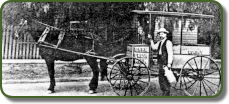 .. .. |
Reche Canyon was once a box canyon area full of natural
vegetation, many deep springs and abundant wildlife; deer, bobcats, quail,
rabbits and coyotes. An old stage road wound along near the tops of the
hills where bandits harassed travelers. They stole horses and cattle and
everything else they could move. One tale maintains that an organized crime
wave in Reche Canyon was broken up after outlaws stole money and as many
sacks of flour as they could carry from a prosperous local flour mill.
What the bandits didn't realize was that in their haste to make a getaway
in the middle of the night, the flour sacks leaked. When the mill was opened
the next morning, a trail of flour identified the route back to the hideout.
At the north entrance to the Canyon, stood “Hollow Hill” dairy, later to
become a restaurant for a short period of time, later a summer school for
children. As time progressed, part of the land became mobile home estates
and part single family houses. Few of the original springs of the Canyon
exist with the water level dropping each year. Rumor still persists of
a mystery gold mine in Reche Canyon but no one knows where to look for
it. |
| 1910 - Colton Fire Department 1889-1998
It is not known of the exact location or who attended
that first meeting to form the Colton Fire Department on February 21, 1888.
Possibly Judge Nicholas Earp, who was appointed the County Recorder seven
months earlier or, perhaps his son Virgil, the town Marshall, or George
Cooley, a ranch owner who was very active in city and county affairs. In
any case, the newly formed department was made up of volunteers from local
businessmen, ranchers, and farmers. |
..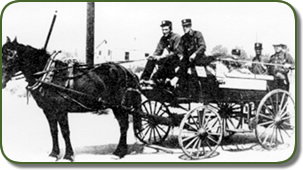 |
The new department fought fires with water buckets as
they had done since Colton's beginning in 1875. The first fire apparatus
was purchased by the City, October 16, 1889. It consisted of one hose cart,
1,000 feet of 2-inch hose and 3 fire extinguishers. This hose cart was
pulled by the firemen throughout the streets of Colton. City Leaders made
the department official November 11, 1889, in a brick building at the corner
of 7 th and “I” street (Valley Blvd.). In May of 1892, the city purchased
a hook and ladder cart that was also hand drawn by the firemen. Both pieces
of equipment were used until 1905, when a horse drawn hose wagon was put
into service. (This wagon still exists and is on loan for display at The
San Bernardino County Museum). The members of the Fire Department asked
the Citizens of Colton for contributions to purchase the horse harness
and tack. The cost was $300.00.
By 1914, progress brought a new motorized engine to the
City of Colton; this was the first motorized engine in the San Bernardino
Valley. Engine #1 was a white triple combination (pump, hose, and chemical
rig). It sported the best trim and gold leaf insignias the decorators could
find. The emblems on the side of the hose bed were gold hubs, representing
the “Hub City.” This engine was chain driven and had solid rubber tires
to support the massive weight.
Pictures of this engine are on display at the Colton Fire
Stations, as well as the Colton Museum. The last remaining pieces of Colton
Engine #1 are at the Pioneer Fire Museum in San Bernardino.
| 1937 - Colton Police Department
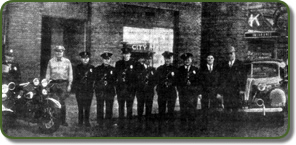 .. ..
|
The Colton Police Department's colorful history began
with its first Chief, Marshall Virgil Earp, in 1887, the year the city
was incorporated. The title of Town Marshall was changed to Chief of Police,
a position appointed by the City Council, in the early 1900's. Originally
the Town Marshall owned his own horse but administered police service from
the new city hall in 1890. He booked prisoners, after transporting them
in a wheelbarrow, into a two-room cell too low for a man to stand in. Colton
grew in square mileage, which required the council to furnish a horse;
they raised the Chief's salary to $75.00 per month. |
A strong foundation for law and order was built as Colton
entered the 20 th Century. In 1884, the last convict was hanged in San
Bernardino for a Colton homicide stemming from a love triangle. The century
cost the lives of two officers in police shootings during 1927. In 1937
the city purchased two police cars and two motorcycles. Technology, as
primitive as it was, allowed the placement of radios in both of those cars.
The police now required a Chief, an Assistant Chief, two sergeants, two
motor officers and four patrolmen.
In early 1932 the Police Department recruited its original
citizen volunteers as merchants walked nightly patrols for the beat officers.
Throughout the 30's, vagrancy and hobos impacted the police calls for service.
Police from all over California looked upon Colton, the Hub City, as an
important point to observe the transient flow for wanted suspects. By 1940
the police department installed radios in all their police cars and the
station. The frequency was shared by neighboring cities; this remained
a constant through the early 1970's. Complaints of speeding vehicles, curfew
violations, panhandling and burglaries have dominated police calls for
100 years.
Colton has grown from a one-man department in 1887; today,
Colton is a full-service police department comprised of three divisions,
staffed by 80 men and women who are responsible for carrying out the department
mission.
| COLTON TODAY
Today the City of Colton encompasses an area of approximately
16 square miles and operates as a general law city, governed by the City
Council, of the State of California. Colton, with a current population
of over 51,000 is located between the Cities of San Bernardino and Riverside,
in the middle of the Inland Empire, one of the fastest growing regions
in the United States. Colton is now a thriving and well-balanced community
offering affordable housing, many family support programs, recreation and
parks, health services, a quality education system, public safety programs,
two community centers, and an aggressive problem-solving government. |
..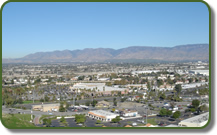 |
The Mayor is separately elected and serves a four-year
term. Six elected Councilpersons serve four-year terms. The City Council
also serves as the Board for the Redevelopment Agency for the City of Colton.
Advising the City Council are a number of appointed citizen commissions
and boards. Other elected officials include the City Clerk and the City
Treasurer who serve four-year terms.
The top appointed officials are the City Manager who oversees
all City operations and the City Attorney who provides legal services to
the City Council and all departments.
Colton is a full-service city staffed by over 300 employees.
Services include public safety (police, fire, and emergency medical services);
planning and inspection services as well as public works maintenance programs;
community development, a full range of people services (recreation for
all ages, library services, child care, youth and family support programs);
all utilities (electrical, water, sewer, refuse collection) except gas;
economic development and redevelopment programs; and administrative services
providing support for all departments.
|